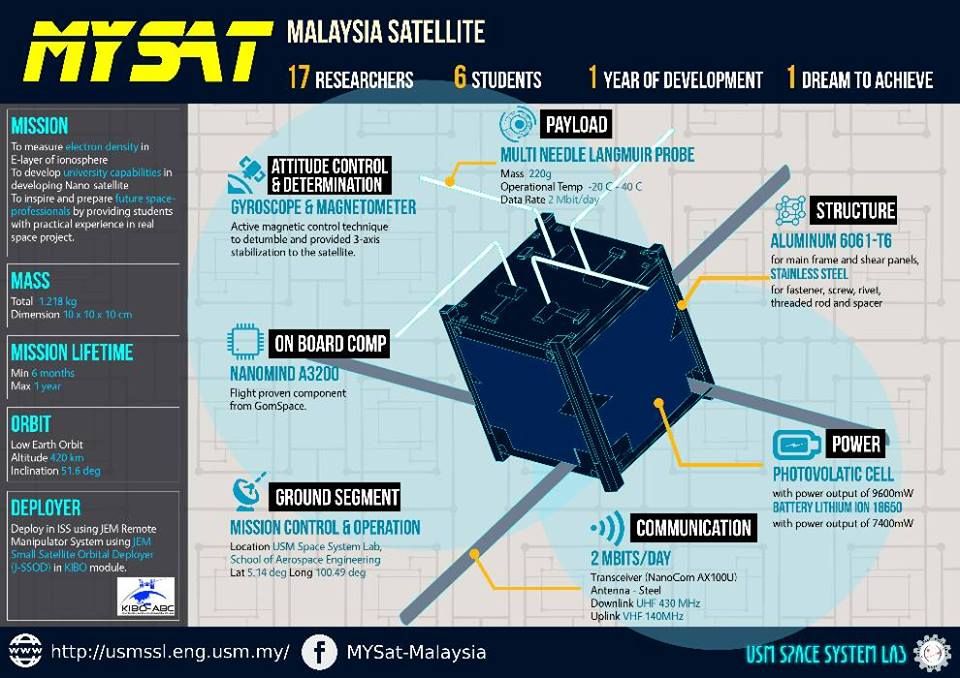
MYSat-Malaysia

Mission StatementSource: MYSat-Cubesat (USM Space System Lab)The atmospheric studies have been conducted all over the world using ground radar system, GPS receiver and space-borne such as satellite and launcher. Atmospheric parameter subject to atmosphere study are electron density, temperature and magnetic field that are sensitive to the variations of D, E and F layers of ionosphere. However, we are lacking of facilities such as satellite and ground radar that provided data for atmospheric studies specifically in South East Asia (SEA) region. The study and observation of ionosphere activity over the SEA is as important as any study conducted all over the world because the data from atmospheric studies can be used in disaster management such as precursor for earthquake and tsunami, lightning and typhoon location, volcanic eruption etc. Almost of 70% of SEA in on Pacific Ring of Fire, this data is very important since this natural disaster will affect the SEA region and a part of South Asia region and leave an impact to socio-economics to the country respectively.Primary Mission ObjectiveSecondary Mission ObjectiveTo measure electron density in ionosphere start from the F layer (400km) to D layer (60 km) for local disaster management Orbital parametersTo develop university capabilities in designing Nano-satellite
To expose student in mission design and analysis Altitude: 350-460 km Inclination: 51.6 degree Perigee: 6719 km Apogee: 6713 km Eccentricity: 0.0005 Orbital Period: ~ 90 min (~5400 sec)
Micro/mini satellites for earthquake studies - toward international collaboration Advances in Geosciences, 2010 K. -I. Oyama, Y. Kakinami, J. Y. Liu, C. Y. Chen and T. KodamaSatellite remote sensing in earthquake prediction. A review National Postgraduate Conference (NPC), 2011 Habibeh Valizadeh Alvan Dept. of Civil Engineering, University Putra Malaysia (UPM), Serdang, Malaysia
Farid Haydari Azad Dept. of Civil Engineering, University Putra Malaysia (UPM), Serdang, MalaysiaGeophysicist Seeks New Quake Forecast Research SSIG, September 12, 2013 TOKYO, Sept 12 (Bernama) – Japanese geophysicist Seiya Ueda has proposed a new type of research for earthquake predictions that takes into account precursor phenomena that have not been used by seismologists, Japan’s Jiji Press reported.Modifications of the ionosphere prior to large earthquakes: report from the Ionosphere Precursor Study Group Geoscience Letter, 2016 K.-I. Oyama, M. Devi, K. Ryu, C. H. Chen, J. Y. Liu, H. Liu, L. Bankov and T. KodamaSpace Environment and Kibo Utilization Workshop (SEKUW) April 18-19 2016 Development of Malaysia Cube-sat Scientific Mission Dr. Norilmi Amilia Ismail, Universiti Sains Malaysia (USM)
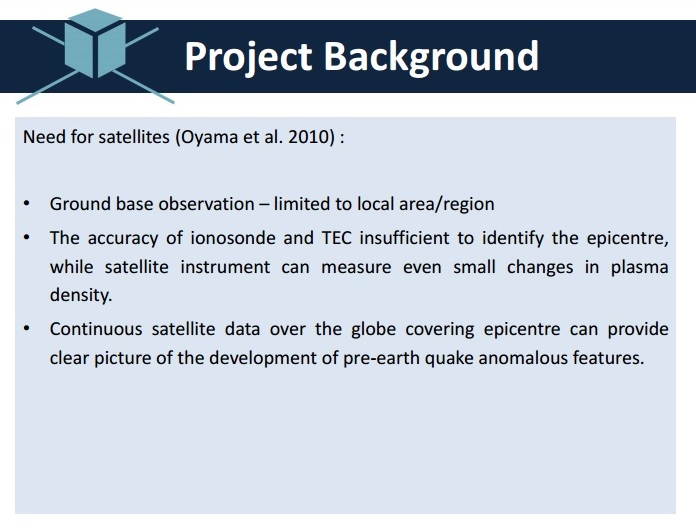
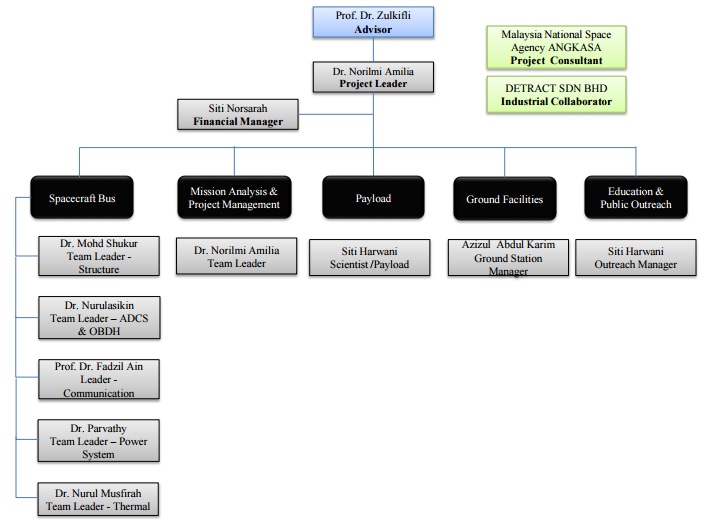
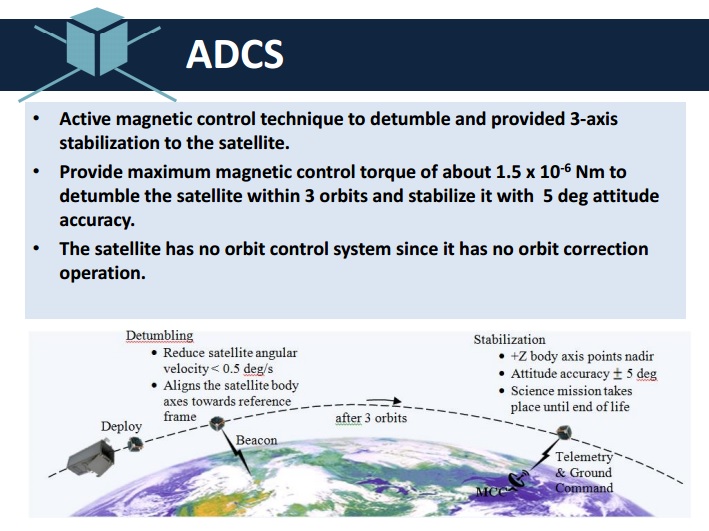
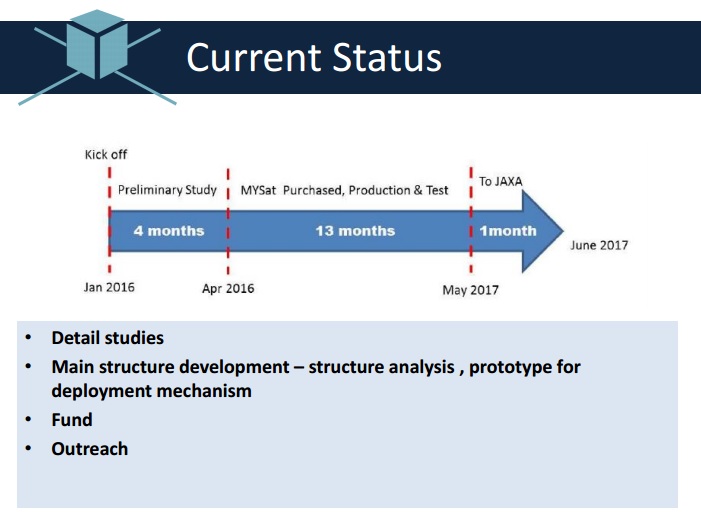
Observation on vertical electron density profile in e-layer ionosphere before Indian-ocean earthquake on December 2004 using CHAMP 2016/10/18 Siti Harwani Md Yusoff, Lim Hwee San, Yoon Tiem LeongThe 23rd Session of the Asia-Pacific Regional Space Agency Forum (APRSAF-23) 15-18 November 2016 Development of MYSat, a 1U University CubeSat Mission
Dr. Norilmi Amilia Ismail, Lecturer
School of Aerospace Engineering, University Sains MalaysiaNANOSATELLITE MYSat TO BE LAUNCHED INTO ORBIT USM, PENANG, 13 January 2017 – A cube-shaped NanoSatellite named MYSat or Malaysia Youth Satellite would be launched into outer space to study the possibility of early detection of earthquakes, the outcome of a research by a group of students and their lecturers from the Universiti Sains Malaysia (USM) School of Aerospace Engineering (PPKA).
The satellite is expected to be launched beginning next year and to be put in orbit between 6 months to a year depending on environmental conditions; the launching will be carried out by astronauts from the Kibo module owned by JAXA (Japan Aerospace Exploration Agency) at the International Space Station (ISS).
The total cost of the programme, which involves a spacecraft bus, payload, launcher, construction and operation of a ground station, and personnel including satellite operators is estimated to be at RM250,000.
* 雙方簽技術交流備忘錄理大生可到航天局實習 [pdf](光明日報)NATGRAD 2017 Orbit Design and Lifetime Analysis of MYSat: A 1U CubeSat for Electron-density Measurement
Ahmad Shaqeer, Norilmi Amilia IsmailMalaysia Belajar Teknologi Pembuatan Satelit Indonesia May 10, 2017 Tidak bisa dipungkiri, Indonesia adalah negara di Asia Tenggara yang paling maju dalam bidang penerbangan dan antariksa. Hal tersebut praktis mengundang beberapa negara tetangga yang tertarik bekerja sama dalam bidang ini. Setelah beberapa waktu yang lalu, Jawatan Perikanan Malaysia berkunjung ke LAPAN untuk berdialog dengan peneliti LAPAN mengenai Zona Potensi Penangkapan Ikan (ZPPI), selanjutnya pada Senin (08/05) Norilmi Amalia dan tim berkunjung ke Pusat Teknologi Satelit (Pusteksat) LAPAN di Bogor.
ANGKASA TALK - Ionosphere Disturbance before Large Earthquake and Problems of Ionosphere Measurement by Tiny Satellite August 14, 2017 Agensi Angkasa Negara (ANGKASA) berbesar hati menjemput Y.Bhg. Datuk/ Dato’/ Prof./ Dr./ Tuan/ Puan untuk hadir sesi syarahan umum di atas pada 14 Ogos 2017, jam 8.30am.
Tujuan syarahan umum ini adalah untuk mewujudkan satu platform kepada pakar sains dari penyelidik bagi berkongsi maklumat saintifik terkini yang menarik secara terus kepada penyelidik, pensyarah, saintis, pelajar prasiswazah dan pasca siswazah.
Prof. Dr. Koichiro Oyama yang merupakan saintis kanan di International Center for Space Weather Sciences and Education (ICSWSE), Kyushu University Hakozaki, Fukuoka, Jepun. Syarahan umum ini terbuka kepada semua komuniti penyelidik dan saintis di Malaysia.
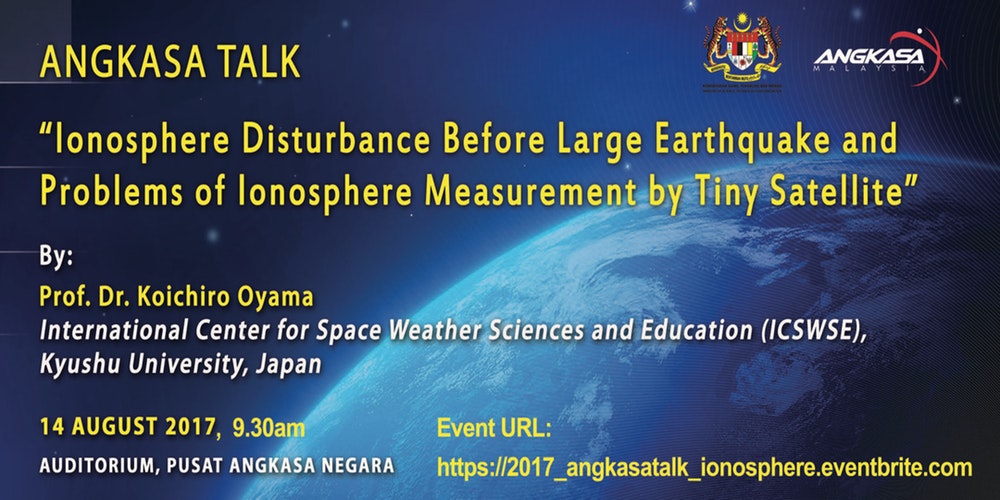
A discussion with Prof Koh-Ichiro Oyama and Dr Hui-Kuan Fang from Institute of Space and Plasma Science, National Cheng Kung University, TaiwanMission Analysis and Design of MYSat - A 1U Cubesat For Electron-density Measurement IAC 2017 Mr. Ahmad Shaqeer Mohamed ThaheerRESEARCH TOPICS FOR FINAL YEAR PROJECT 2017/2018 Development of Electron Temperature and Density Probe (TeNeP) for MYSAT: Pn. Siti Harwani Md YusoffBMKG Builds Geomagnet Station to Observe Earth Magnetic Field 30 January 2018 Meteorology, Climatology and Geophysics Agency (BMKG) has built a geomagnet station to observ the earth's magnetic field in North Lombok regency, West Nusa Tenggara..
Head of Mataram Geophysics Station Agus Riyanto, said the station is built on land owned by Islamic Boarding School of Nurul Bayan, in Bayan District. The earth's magnetic field data can be utilized for earthquake precursors useful for research.
The selection of North Lombok Regency as the location is based on the area being prone to earthquake and tsunami.
"So the geomagnet station was built in 2017 to provide initial information if there is an earthquake," said Agus, Monday (1/29/2018).
* The MAGDAS project The past and next 10 years (UNOOSA)Space Generation [ASEAN] 2018 January 31 Norilmi Amilia Ismail (Subject Matter Expert)Possibility of strong quake needs further study: BMKG April 6 2018 The Meteorology, Climatology and Geophysics Agency (BMKG) clarified on Thursday that the possibility of a 8.7-magnitude earthquake striking the Sunda Megathrust, which it raised in late February, could not be ascertained yet as the matter required further study.
The agency plans to cooperate with Kyushu University in Fukuoka, Japan, to conduct a seismic precursor study assessing soil condit...
* Brief Study Earthquake Precursor with ULF Band Geomagnetic in Indonesia as Preliminary Research MAGDAS-9 BMKG-SERC In Sumatera, INDONESIA15th Annual CubeSat Developer's Workshop program A “ThinSat” to Determine Ionospheric Drag and Local Plasma Dynamics John Roser U.S. Naval Academy
Measuring Electron Density in the Ionosphere to Detect Precursors of Seismic Events Aryan Lobie University of Auckland
Design of The ADCS of MYSat-1 Adham Alkhaja Khalifa University of Science and Technology
Interpretation of Double Langmuir Probe I-V Characteristics at Different Ionospheric Plasma Temperatures Shankar Bhattarai MSc Physics, Department of Physics, Patan Multiple Campus, Tribhuvan University, Lalitpur, Nepal
* Will ThinSats inspire the next generation of engineers and scientists? | History of CubeSatsInternational Conference on Aerospace and Mechanical Engineering (AeroMech17) 1 June 2018 Comparative study of MYSat attitude stability effect on power generation and lifetime
Norilmi Amilia Ismail, Ahmad Shaqeer Mohamed Thaheer and Mohd. Izmir YaminUiTM, the nation's first nano-satellite smooth university into space June 29, 2018 "The satellites have six missions, including image retrieval, testing satellite location correlations, Global Positioning System (GPS) chip tests, measuring the magnetic field in space for geomagnetic mapping data in Southeast Asia and radio communications.
UiTM students just launched a satellite into space! And you won’t guess how much it cost… 06/07/2018 There were traces of a Universiti Sains Malaysia (USM) project named MYSat, which is also a CubeSat that aimed to collect data from orbit that may help detect earthquakes. The whole project cost was estimated to be around RM25,000, and it was expected to be launched sometime this year. However, we’ve failed to find any other information related to the current status of the project. The last post on MYSat’s social media page had been in January last year.Penggabungan Agensi Angkasa Negara (ANGKASA) dan Agensi Remote Sensing Malaysia (ARSM) bagi membentuk Agensi Angkasa Malaysia (Malaysian Space Agency – MYSA) 2019-03-04
USM Space System Lab | MYSat-Malaysia (Facebook) JEM Small Satellite Orbital Deployer: J-SSOD (JAXA) Ionosphere and Space Weather System (Angkasa) InnoSat | TiungSat 1 (MySat 1, Malaysian-OSCAR 46, MO 46) (Gunter's Space Page) Thailand Space Weather Information and Applications Center MAGDAS Data Archive | MAGDAS-II MAGDAS-9 REALTIME PLOT